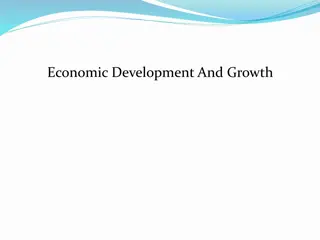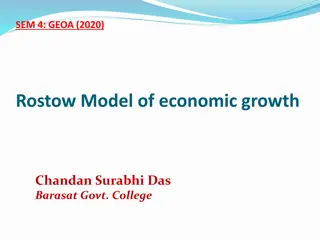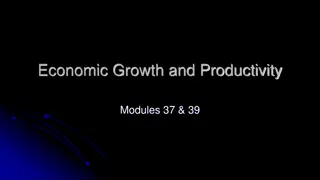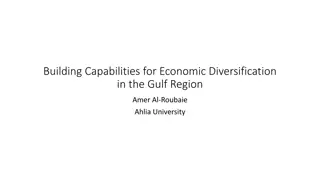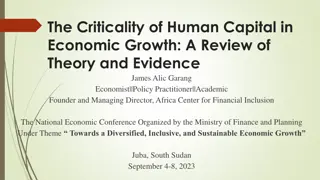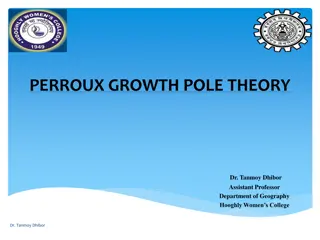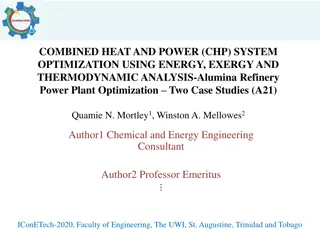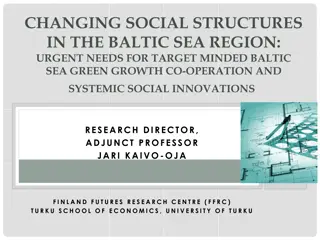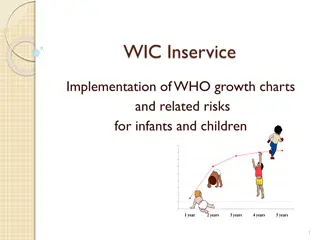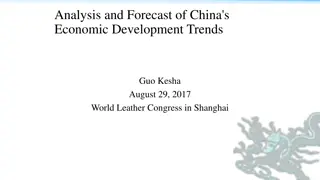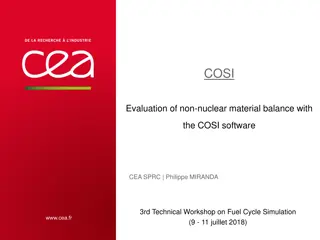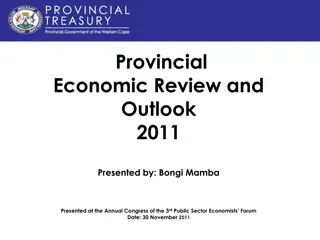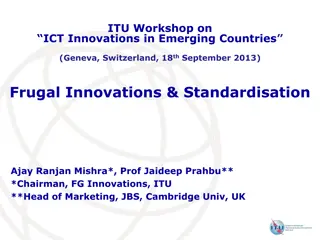Exergy, Economic Growth, and Degrowth: A Critical Perspective
This presentation delves into the relationship between exergy, economic growth, and degrowth from a thermodynamic perspective, exploring the origins of exergy-economics and physical ideas. It emphasizes the importance of exergy as a measure of useful work in economic systems, contrasting energy and exergy efficiencies while highlighting the role of labor and capital activation. The concept of exergy as a factor of production and its implications for understanding energy transformations and efficiency are discussed in detail, providing insights into the critical role of exergy in sustainable economic development.
Download Presentation

Please find below an Image/Link to download the presentation.
The content on the website is provided AS IS for your information and personal use only. It may not be sold, licensed, or shared on other websites without obtaining consent from the author.If you encounter any issues during the download, it is possible that the publisher has removed the file from their server.
You are allowed to download the files provided on this website for personal or commercial use, subject to the condition that they are used lawfully. All files are the property of their respective owners.
The content on the website is provided AS IS for your information and personal use only. It may not be sold, licensed, or shared on other websites without obtaining consent from the author.
E N D
Presentation Transcript
Exergy, Economic Growth and Degrowth Presentation at the International Energy Economics Workshop University of Sussex Brighton, U.K. July 13-15, 2016
Origins of Exergy-Economics Physics and thermodynamics Economic ideas since the physiocrats Life as a dissipative system far from equilibrium The ecological analogy
Origins of Physical Ideas Three laws of motion (Newton, 16xx ) Phlogiston (Becher,1667) Conservation of vis viva (Leibnitz (1695) Caloric (Lavoisier/Laplace, 1783) Mechanics (Lagrange, Hamilton, et al) Heat engine theory (Carnot, 1826) Kinetic energy (Coriolis, 1829) Mech equiv. of heat (Mayer 1842)
Physics, cont Conservation of energy (Helmholtz, 1847) Entropy definition (Clausius 1854) Thermodynamics as a subject (Kelvin/ Joule/ Rankine, 1860s) Chemical potential (exergy) (Gibbs 1874) Statistical mech. (Maxwell, Boltzmann/ Gibbs) Non-equilibrium thermo (Prigogine et al) APS summer study (Carnahan et al 1975)
A Critical Perspective: Energy, Exergy and Useful Work Energy is conserved. The energy input to a process or transformation is always equal to the energy output. This is the First Law of thermodynamics. However the output energy is always less available to do useful work than the input. This is the Second Law of thermodynamics, sometimes called the entropy law. Energy available to do useful work is exergy. Exergy is a factor of production.
Exergy and Useful Work, Cont Capital is inert. It must be activated. Most economists regard labor as the activating agent. Labor (by humans and/or animals) was once the only source of useful work in the economy. But machines (and computers) require a different activating agent, exergy that can be converted to useful work (in the thermodynamic sense). For economic growth models, useful work can be considered as a factor of production.
Efficiency: Two kinds Energy efficiency (First Law) is useful output divided by total input (of energy as fuel or feedstock). This measure is quite deceptive, but common. (See slides following) Exergy efficiency (Second Law) is a different ratio. The numerator is work actually done in the process. The denominator is the potential work (exergy) that could have been done in an ideal process allowing only for irreversibilities.
Energetics, biology, ecology Energetics (Helm, 1887) As Monism W. Ostwald (1895- ) Technocracy H. Scott with M. King Hubbert (1931- 55) Mathematical biology (Lotka, Rashevsky) In ecology (H. Odum, R. Costanza, Hall, et al) In economics & ecology (B. Hannon et al)
Economics w/o Energy Trade and division of labor as source of added value (Smith, Ricardo, et al) Labor surplus as source of wealth (Marx) Production function of K,L (Cobb, Douglas) Optimal growth (Ramsey, 1929) Neoclassical growth in equilibrium (Solow, et al, 1954) Limits to growth debunked (Solow, Stiglitz, Nordhaus et al, 1974 ) Endogenous theory (Romer, Lucas et al)
Economics with Energy The coal question (Jevons, 1954) From energetics F. Soddy (1922- 36) From cowboy to spaceship (Boulding 1966) Mass balance economics (Kneese et al,1969) Limits to Growth (Meadows et al, 1972) Entropy in economics (Georgescu-Roegen, 1971) Energy as factor of production (Hannon, 1981, Kuemmel, 1985)
Most economists assumption #1 That resource (i.e. energy, or exergy) scarcity is not a problem. Increased consumption, from (assumed) economic growth, can be met by increased supply at no increase in price. (This was explicit in the 2010 IMF forecast and all IEA and EIA forecasts up to 2006.) It implies that the energy return on energy investments (EROEI) will be constant over time.
Economists Assumption #2 That the global economy grows, in equilibrium, at a steady rate (around 3 -4 percent p.a.) driven by labor augmenting technical progress, which is constant. People living 100 years from now will therefore have incomes more than 10-fold greater than today.
Economists assumption #3 That investment choices (in the equilibrium model) are always optimal because firms maximize profits and consumers maximize utility, over time. In this case there are no free lunches meaning no investment opportunities that would have negative costs or very low costs compared to typical practice. It follows that GHG abatement policies must be costly.
Standard production functions If the cost share theorem is accepted, if the cost shares of capital and labor are constant over time, and if the two factors (capital and labor) are independent and substitutable) one obtains the standard Cobb-Douglas production function with constant exponents (next slide). If substitution between the factors is restricted, but constant over time, one obtains the Constant elasticity of substitution (CES) model. (Not discussed). If energy is included in either model, the cost-share theorem is still assumed to be valid. The constant elasticity of scale requirement simply means that the exponents add up to unity.
Ayres IIASA 10 August 2007 Standard (Cobb-Douglas) production functions ( ) = Y Q A , H , G L , F R , K t t t t t t t t ( ) ( ) ( ) = Y A H G L F R K t t t t t t t t Ytis output at time t, given by Q a function of, Kt , Lt , Rt inputs of capital, labor and natural resource services. , + + = 1, (constant returns to scale assumption) Atis total factor productivity Ht, Gtand Ftcoefficients of factor quality
The Role of Energy in Economics Endogenous economic growth theory since Solow assumes that energy is an intermediate good produced by capital and human labor, plus knowledge embodied in human capital . The energy sector is small, a few percent of GDP (depending on prices) and cannot explain growth An old income allocation theorem says that the output elasticity of energy must be equal to its cost share. But the cost share is too small to matter.
Exergy (E) Austria, Japan, UK & US: 1900-2005 (1900=1) index 18 USA Japan UK Austria 16 14 12 10 8 6 4 2 0 1900 1920 1940 1960 1980 2000
Useful Work (U) Austria, Japan, US, UK: 1900-2000 index 90 80 USA Japan UK Austria 70 60 50 40 30 20 10 0 1900 1920 1940 1960 1980 2000
US Exergy and Useful Work per $ GDP watts total exergy / $GDP watts useful work / $GDP 10 year moving average 18 16 14 12 kWh / $GDP 10 8 6 4 2 - 1900 1905 1910 1915 1920 1925 1930 1935 1940 1945 1950 1955 Year 1960 1965 1970 1975 1980 1985 1990 1995 2000 2005
KWh Useful Work / $GDP kWh of useful work per $GDP 10 per. Mov. Avg. (kWh of useful work per $GDP) 1.0 0.9 0.8 0.7 kWh / $GDP 0.6 0.5 0.4 0.3 0.2 0.1 0.0 1900 1910 1920 1930 1940 1950 1960 1970 1980 1990 2000 Year
US Electric Efficiency,1900-2005 Primary Efficiency, Delivered Electricity Ten year Moving Average Final Efficiency raw energy to useful work 10 year moving average 35% 30% 25% % Efficiency 20% 15% 10% 5% 0% 1900 1910 1920 1930 1940 1950 1960 1970 1980 1990 2000 Year
Conversion Efficiency, Exergy to Useful Work Conversion efficiency to useful work 5 per. Mov. Avg. (Conversion efficiency to useful work) 14% Percent of raw exergy to useful work 12% 10% 8% 6% 4% 2% 0% 1900 1910 1920 1930 1940 1950 1960 1970 1980 1990 2000 Year
Conversion Efficiency, Exergy to Useful Work work 1960-2005 % input exergy to useful work 5 per. Mov. Avg. (% input exergy to useful work) 14% 13% % efficiency of conversion 12% 11% 10% 9% 1960 1965 1970 1975 1980 1985 Year 1990 1995 2000 2005
Alternate economic assumption #2 That the economy is never in general equilibrium. Economic growth for the past 200 years has depended very largely on innovations, such as mechanization and automation, requiring cheap energy. The term labor-enhancing is misleading; labor displacing is more accurate. See Ayres & Warr The Engine of Growth
LINEX theory (Including ICT) physics assumptions (constraints) determine the mathematical form of the output elasticities, which are partial derivatives. Partial integration yields the LINEX production function. Parameters are determined by non-linear fits of the theoretical function against real economic history over the past 100 years. ICT has become important since 1990. We treat information capital as a perturbation of total capital, using the standard Taylor expansion. Setting the ICT correction term to zero yields the simpler form.
ICT adjusted LINEX + u l l = + + * exp y q u f a ab c k u l y = GDP u = useful work l = labour k = capital stocks (total) = ICT capital stocks [q,a,b,c] = fitting parameters
Ayres IIASA 10 August 2007 Empirical and estimated GDP US 1900-2000 excluding 1941-1948 US GDP (1900=1) 25 GDP estimate LINEX 20 GDP estimate Cobb- Douglas Empirical GDP 15 10 POST-WAR COBB DOUGLAS alpha=0.51 beta=0.34 gamma=0.15 PRE-WAR COBB DOUGLAS alpha=0.37 beta=0.44 gamma=0.19 5 0 1900 1920 1940 1960 1980 2000 year Empirical GDP from Groningen GGDC Total Economy Growth Accounting Database: Marcel P. Timmer, Gerard Ypma and Bart van Ark (2003), IT in the European Union: Driving Productivity Divergence?, GGDC Research Memorandum GD-67 (October 2003), University of Groningen, Appendix Tables, updated June 2005
US GDP 1946-2000 US GDP 1946-2000 30.00 25.00 GDP index (1900=1) 20.00 GDP estimate 15.00 Parameters Parameters 10.00 q q 1.66 1.66 a a 0.37 0.37 5.00 b b 2.43 2.43 c c 0.62 0.62 0.00 1946 1950 1954 1958 1962 1966 1970 1974 1978 1982 1986 1990 1994 1998 year
Conclusion Useful work explains past economic growth rather well, with only 2(or 3) parameters, replacing the exogenous productivity multiplier. Granger causality analysis confirms that GDP growth does not drive energy consumption, but useful work does drive GDP growth. This relationship holds significant implications for economic policy
Ill stop here. Thanks for listening The rest is an Appendix
US Estimated Energy Efficiencies (LLNL, Based on DOE) Sector 1950 1970 1990 2000 2008 Electricity Generation Residential & Commercial 0.25 0.36 0.33 0.31 0.32 0.73 0.75 0.75 0.75 0.80 Industrial 0.72 0.75 0.75 0.80 0.80 Transport 0.26 0.25 0.25 0.20 0.24 Aggregate 0.50 0.50 0.44 0.38 0.42
A dangerous deception Even the first law efficiency (useful output divided by total input) of the industry and buildings sectors cannot be 80%. But the energy department has been publishing this nonsense since the early 70s (and back-dated to 1950) mainly to prove that US energy efficiency is high, so conservation is a waste of effort and new (nuclear) supply is needed. In reality, the opportunities for energy efficiency are the most cost-effective source of new supply today.
Energy Intensity vs Energy Efficiency A great many analysts try to use energy intensity (inverted) as a proxy for energy efficiency. They use decomposition analysis to allow for structural change over time (the changing mix of outputs). However, the residual is not a good measure of changing efficiency. Because energy intensity will decline anyhow for other reasons (the Solow residual term) : Calculate E/Y using the Cobb-Douglas P.F.
Energy Intensity and Work Intensity Energy intensity is defined as the energy required to produce a unit (dollar) of GDP, or E/GDP. E is in physical units, such as Exajoules, GDP in $ Work intensity is the work required to produce a dollar of GDP. Notice that work intensity continued to increase untilt he early 1970s.
Model - Energy Intensity of GDP, USA 1900-2000 index 30 25 20 15 r/gdp 10 5 e/gdp 0 1910 1920 1930 1940 1950 1960 1970 1980 1990 2000
Exergy Intensity of GDP Indicator 60 Distinct grouping of countries by level, but similar trajectory US 50 Evidence of convergence in latter half of century EJ / trillion $US PPP 40 UK Slowing decline 30 20 Japan 10 0 1905 1925 1945 1965 1985 2005 year
Exergy to Useful Work Conversion Efficiency Evidence of stagnation Pollution controls, Technological barriers Ageing capital stock Wealth effects 25% High Population Density Industrialised Socio-ecological regimes 20% Japan Resource limited efficiency (%) 15% US 10% UK Low Population Density Industrialised New World Socio-ecological regime 5% Resource abundant 0% 1905 1925 1945 1965 1985 2005 year




